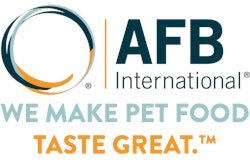
No matter how well formulated and produced a petfood may be, all that nutrition and quality won't do any good if the animal won't eat it. Thus, suppliers are continually conducting research and offering innovations to help manufacturers make their products more palatable. From collaboration with clients to natural ingredients to processing techniques and equipment, examples of new ways to improve palatability abound.
New research center available to manufacturers
AFB International, a petfood palatability enhancement company, takes a partnership approach with its customers and aims to contribute to all aspects of petfood development and manufacturing, according to Cheryl Murphy, product manager. For these reasons, the company has established a new research facility, the Lovejoy Resource Center.
Opened in fall 2006 as part of the new AFB headquarters, the resource center gives petfood manufacturers access to a state-of-the-art facility for product development and flavor enhancement, Murphy says. The center is located on six acres in St. Charles, Missouri, USA, just west of St. Louis. It includes 16,000 square feet of laboratory space adjacent to a comprehensive process research lab.
"The Lovejoy Resource Center allows AFB's customers to improve current products and more efficiently and effectively develop the next generation of petfoods," says Murphy.
At the center, AFB's staff of flavor chemists, biochemists, food technologists, process engineers, animal scientists and process technicians can partner with customers in an environment that provides access to equipment and processes applicable to the marketplace. Testing can be conducted on the application of palatant systems and alternative kibble formulations.
Extruded products can be measured for texture and shape acceptance. Canned, semi-moist and dry petfood products can be evaluated in terms of palatability.
"AFB's scientific staff leads the industry in their understanding of petfood manufacture, flavor creation, sensory analysis, animal nutrition and analytical and protein chemistry," Murphy adds.
The scientists team up with AFB's process engineers who are experienced in all areas of flavor development. This allows AFB to produce a steady stream of new flavor products and innovations for their customers.
Natural palatants
Immediate acceptance of offered food is often the pet owner's criterion for nutritional desirability, says Slobodan Baskot, R&D assistant with BHJ Pet Food in Graasten, Denmark. Research with flavor enhancers has proliferated, and many different enhancers, both liquid and dry, are available, ranging from ones added in minute quantities to macro-additives.
Baskot conducted an experiment to evaluate the effect of two palatability enhancers of dry extruded dog food: freeze-dried rumen of cattle and freeze-dried swine liver. The purpose was to show the importance of including natural palatability enhancers in petfood manufacturing, Baskot says.
The feed was processed in a twin screw extruder using the same conditions and equal conditioner temperature of 82°C (180°F) but carried out three times to produce three types of dry extruded dog food: feed 1 (control diet-Labb Active), feed 2 (Labb Active with 2% freeze dried cattle rumen) and feed 3 (Labb Active with 2% freeze-dried swine liver). Tests such as dry weight measurement, bulk density, Holmen durability and strength at rupture showed adding the freeze-dried rumen or liver to the control diet during and after extrusion caused only minor changes in the chemical composition of the feed, Baskot explains.
For the preference tests, 40 dogs were divided into two groups. Food preference was determined entirely by the owners' interpretation of the dogs' response, Baskot says. Owners recorded daily the different kinds of dog food used and commented on the dogs' response. Each dog owner received the control feed (1) and one of the two flavor-enhanced feeds (feed 2 or feed 3). Each dog was offered equal amounts of both feeds simultaneously at feeding time, once or twice per day; no dogs had continuous access to feed.
The results (see Figures 1 and 2) showed feed 3, with freeze-dried swine liver as a pure natural palatant, was consumed by the dogs more than the other two types. Feed 2, with freeze-dried rumen added, did not induce a preference over the other feeds. When a dog showed no preference, it chose a random feed from the two offered and chose not to consume the alternative feed more than 75% of the time. None of the dogs preferred feed 1 (the control) more than 75% of feeding times. Most dogs (93%) also ate the other feed type after eating the preferred feed first. This indicated the dogs involved had good appetite and that feed 1 also had satisfactory taste, Baskot says.
"These results point out the need for further research on dog feeding behavior and awareness of the importance of natural palatability enhancers for commercial petfood," he concludes.
Palatability and processing
SPF, a palatability company, and Clextral, a twin screw extruder manufacturer, have partnered during the last few years to quantify the effect of extrusion on palatability, according to Laurent Garcia of Clextral. The companies have also investigated new ways, such as encapsulation, to enhance the palatability of extruded petfoods.
In one example of this partnership, the petfood sample was manufactured at the Clextral research center in Firminy, France, using an Evolum53 twin screw extruder and the Rotante (rotary) dryer, Garcia says. "The kibbles were coated in the SPF laboratory in Elven, France. Finished products were then tested with cat and dog panels at Panelis. Each palatability test was conducted with 40 cats or dogs," he adds.
To quantify the effects of density on palatability, the first trials included extruding and drying two different standard and premium formulations of cat kibbles to produce three densities: 330 g/l, 380 g/l and 440 g/l. Palatability tests were conducted using two different fat and palatability enhancer applications. The final moisture content was the same for all the trials, Garcia says, and the results showed cats significantly preferred the lowest kibble densities.
A second program, aimed at leveraging the capabilities of twin screw extrusion to incorporate encapsulated palatability enhancers in a matrix, involved injecting palatants directly into the extruder or premixer. "The extrusion parameters were set to properly control the mixing and shear rate in the extruder and preserve the ingredients, while producing a satisfactory kibble," Garcia explains. Several levels of palatants were incorporated into the product and tested against product with no encapsulated enhancers.
Trials used four different kibbles for cats and two types of kibbles for dogs. Overall, the cats and dogs showed a significant preference for several types of kibbles with encapsulated enhancers, even if the products were coated with fat and liquid palatability enhancers. "These promising results have encouraged SPF and Clextral to pursue their cooperation for the benefit of petfood manufacturers," Garcia says.
Mixer to improve kibble taste
According to Dinnissen Process Technology, a paddle mixer makes it possible to significantly improve the taste of cat kibbles. "The secret is quite simple: It allows you to add liquid as well as dry palatability enhancers, precisely and evenly, to each individual kibble," says Peter Raeven, project manager, of Dinnissen Process Technology. "This is very important for cat food in particular, as cats have the habit of inspecting their meal, kibble for kibble, before eating."
Besides selecting appropriate, high-quality palatants, ensuring they are added to the food the right way is important. A tool such as the Pegasus Paddle Mixer from Dinnissen offers such a way, Raeven says. A fixed and precisely weighed quantity of food is introduced into the sealed batch coater, wherein contrast to continuous operation systemsthe entire process of adding liquid and dry palatability enhancers to the kibbles takes place. "For each batch of food, the exact quantity of fat, liquid and dry palatability enhancers needed can be weighed out and added. The process conditions, including temperature, kibble rotation speed, residence time of the food in the mixer and total processing time, can also be precisely controlled," Raeven adds.
The result is a precise and even distribution of the palatability enhancers over the product, according to Dinnissen. In addition, the strength of the bond between the palatability enhancer and the kibble can be optimized, and each individual kibble can be coated with a tough protective layer to ensure the palatability enhancers remain intact during transport, Raeven says.

















